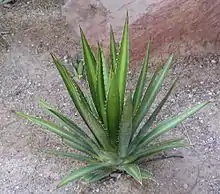Agave lechuguilla
Agave lechuguilla (common name in Chihuahua: lechuguilla, meaning "small lettuce") is an Agave species found only in the Chihuahuan Desert, where it is an indicator species.[4] It typically grows on calcareous soils.[5] The plant flowers once in its life, then it dies. The flowers are a source of nutrients for insects, bats, and some birds.
| Agave lechuguilla | |
|---|---|
 | |
| Scientific classification | |
| Kingdom: | Plantae |
| Clade: | Tracheophytes |
| Clade: | Angiosperms |
| Clade: | Monocots |
| Order: | Asparagales |
| Family: | Asparagaceae |
| Subfamily: | Agavoideae |
| Genus: | Agave |
| Species: | A. lechuguilla |
| Binomial name | |
| Agave lechuguilla | |
| Synonyms[3] | |
| |
The leaves are long, tough, and rigid, with very sharp, hard points which can easily penetrate clothing and even leather, giving the colloquial name "shin-daggers". Mexican people have used fibers from the leaves (commonly called ixtle)."
The water stored in the flowering stalks of this plant, rich in salts and minerals, is sold in Mexico as a sport drink. The plant makes up a large part of the diet of the collared peccary (javelina) in some areas.[6] It is toxic to cattle and sheep, however.[7] Roots of the plants were used as soap by Native Americans.[8]
The plant reproduces most often through underground offshoots, creating large colonies.[8] It also can flower anytime after the plant has reached three to twenty-one years of age, producing a leafless stalk that can reach 3.7 metres (12 feet) in height.[8] The flower clusters are located at the top and are funnel shaped in purples, reds and yellows.[8] The plant dies after flowering.[8]
Charles Wright first collected the plant in 1849 and it was described by John Torrey in 1859.[8]
References
- "Agave lechuguilla". IUCN Red List of Threatened Species. 2019. 2019. Retrieved 17 June 2019.CS1 maint: ref=harv (link)
- "Agave lechuguilla". Germplasm Resources Information Network (GRIN). Agricultural Research Service (ARS), United States Department of Agriculture (USDA). Retrieved 2011-05-02.
- Kew World Checklist
- West, Steve (2000). Northern Chihuahuan Desert Wildflowers. Globe Pequot. p. 44. ISBN 978-1-56044-980-5.
- Turner, Matt (2009). Remarkable Plants of Texas: Uncommon Accounts of Our Common Natives. Austin: University of Texas Press. pp. 109–113. ISBN 978-0-292-71851-7.
- Corn, J. L. and R. J. Warren. (1985). Seasonal food habits of the collared peccary in South Texas. Journal of Mammalogy. 66:1 155-59.
- Lechuguilla. Archived April 3, 2012, at the Wayback Machine Toxic plants of Texas. Texas A&M.
- Morey, Roy (2008). Little Big Bend : Common, Uncommon, and Rare Plants of Big Bend National Park. Lubbock: Texas Tech University Press. p. 37. ISBN 9780896726130. OCLC 80359503.
Further reading
- Flora of North America Editorial Committee (ed.). "Agave lechuguilla". Flora of North America North of Mexico (FNA). New York and Oxford – via eFloras.org, Missouri Botanical Garden, St. Louis, MO & Harvard University Herbaria, Cambridge, MA.
- Thacker, H. 2013. Agave lechuguilla. "Least Concern ver 3.1", The IUCN Red List of Threatened Species. Version 2014.3.
External links
 Data related to Agave lechuguilla at Wikispecies
Data related to Agave lechuguilla at Wikispecies Media related to Agave lechuguilla at Wikimedia Commons
Media related to Agave lechuguilla at Wikimedia Commons- USDA Plants Profile for Agave lechuguilla (lechuguilla)
- University of Michigan - Dearborn: Native American Ethnobotany: Agave lecheguilla (Maguey lechuguilla)
